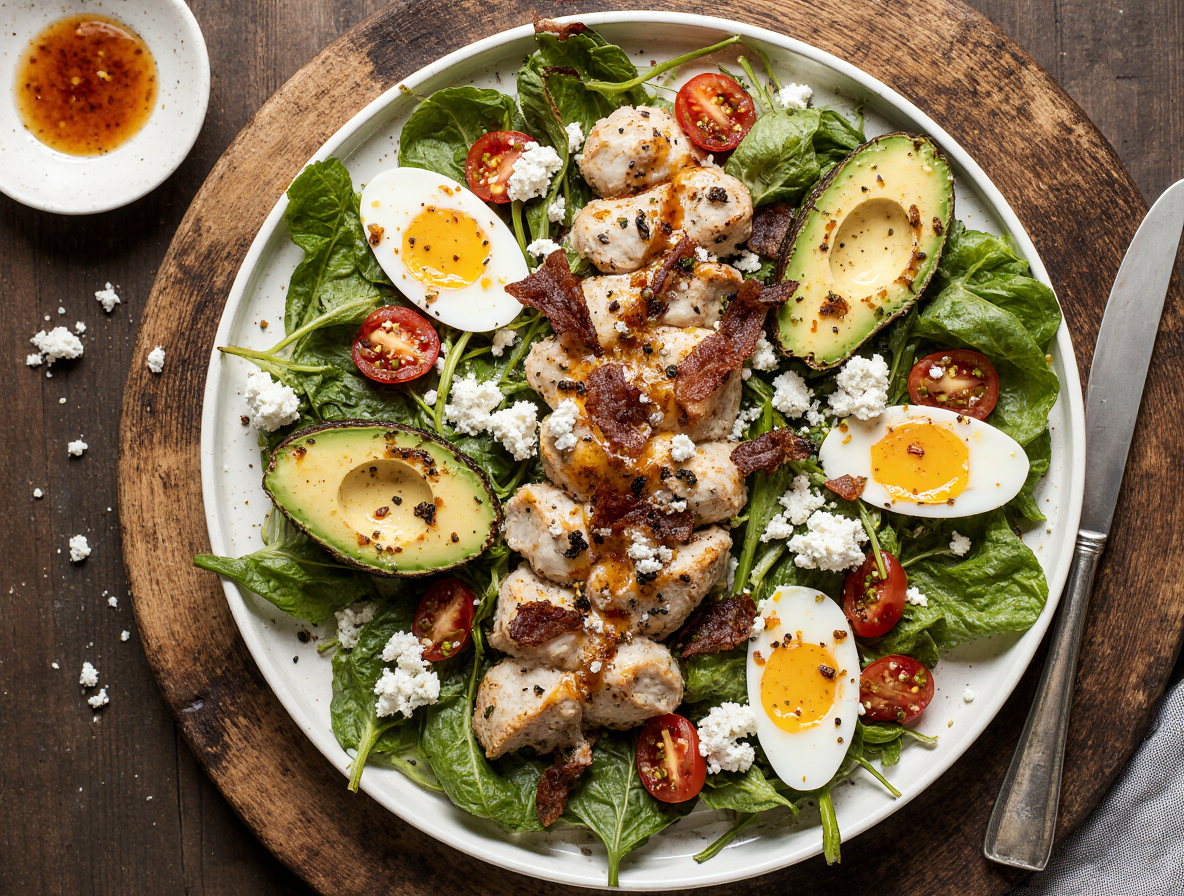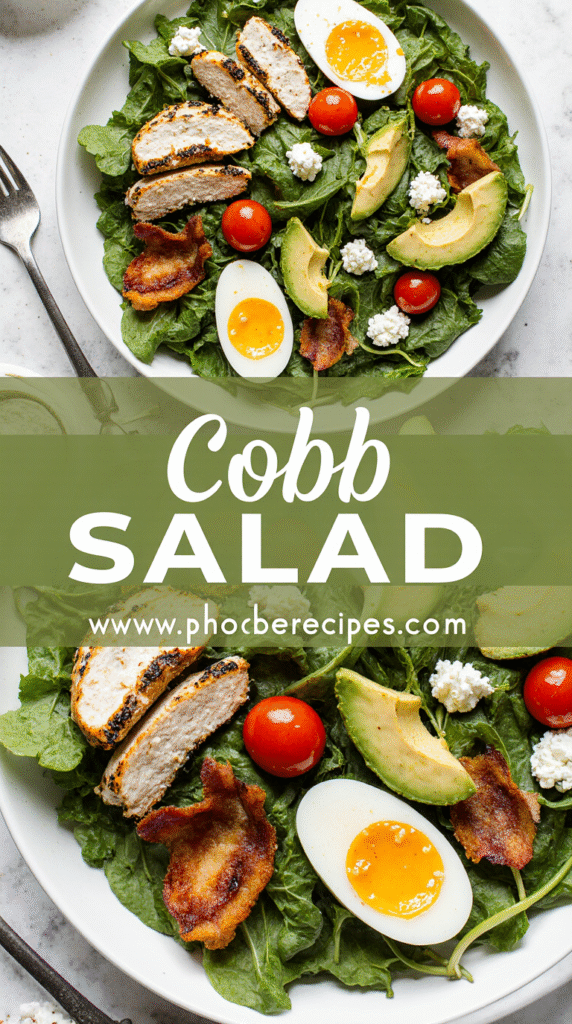How to Make the Perfect Cobb Salad Recipe: A Chef’s Secret Guide
Did you know that a classic Cobb salad packs 525 calories per serving with an impressive 32g of protein?
We love how this iconic American dish combines the perfect balance of flavors and textures in one bowl. At its core, a Cobb salad recipe features crisp lettuce topped with neat rows of bacon, chicken, hard-boiled eggs, tomatoes, and other delicious ingredients. While the exact origins remain somewhat debated, many food historians believe it was created in 1937 at the Hollywood Brown Derby restaurant when owner Robert Cobb tossed together leftover kitchen ingredients—accidentally creating what would become a culinary classic.
Not only is this versatile salad hearty and satisfying, but it’s also incredibly easy to prepare and perfect for meal prep. Whether you prefer the traditional combination of romaine and watercress lettuce with cucumber, shallots, cheese, and a red wine vinaigrette, or you want to explore creative variations, I’ll guide you through creating the best Cobb salad recipe step by step. From properly cooking each component to arranging those signature ingredient rows, we’ll cover everything you need to know about how to make a perfect Cobb salad that rivals any restaurant version.
What Makes a Cobb Salad Unique
What Makes a Cobb Salad Unique
The story behind the traditional Cobb salad
The Cobb salad stands apart from other salads due to its distinct presentation and rich history rooted in Hollywood glamor. Unlike tossed salads, a traditional Cobb salad is a “composed” salad—meaning its ingredients are thoughtfully arranged in neat rows or piled separately atop a bed of lettuce.
The most widely accepted origin story takes us back to 1937 at the legendary Brown Derby restaurant in Los Angeles. According to popular legend, restaurant owner Robert Howard Cobb was hungry late one night and created an impromptu midnight snack from leftovers in the kitchen refrigerator. He gathered lettuce, hard-boiled eggs, crisp bacon, roasted chicken, avocado, tomatoes, and blue cheese, added some French dressing, and thus the iconic Cobb salad recipe was born.
However, several competing stories exist about who deserves credit for this culinary creation. Some accounts suggest that Robert Cobb himself invented it, yet others claim the restaurant’s chef, Paul J. Posti, was the actual creator. Another interesting variation of the tale involves Hollywood showman Sid Grauman, for whom the salad was supposedly prepared. This version states that the ingredients were chopped finely because Grauman had recently undergone dental work and couldn’t chew properly.
How it became a classic American dish
Despite uncertainty surrounding its exact creation, the Cobb salad quickly captured the essence of California cuisine—fresh, flavorful, and unpretentious. Once added to the Brown Derby menu, the salad’s popularity soared among Hollywood elites. Movie mogul Jack Warner reportedly sent his chauffeur regularly to pick up cartons of this mouth-watering creation.
The Brown Derby restaurants sold over 4 million Cobb salads before the original Hollywood locations closed. This remarkable statistic underscores how thoroughly this dish penetrated American food culture.
What truly cemented the Cobb salad as an American classic was its perfect balance of versatility and substance. As a main course rather than a side dish, it offered a complete meal with protein, vegetables, and satisfying fats. Furthermore, its straightforward preparation makes it accessible for home cooks, allowing for personalization while maintaining its distinctive character.
Today, Cobb salad remains a testament to culinary improvisation becoming timeless tradition. Its enduring appeal lies in the balance of textures and flavors that continues to satisfy diners decades after that famous late-night kitchen raid.
Essential Cobb Salad Ingredients
Essential Cobb Salad Ingredients
Lettuce: romaine vs. iceberg
The foundation of any perfect Cobb salad begins with the right lettuce. Traditionally, romaine lettuce and watercress form the authentic base, providing a spicy, crunchy foundation for the remaining ingredients. Romaine offers a satisfying crunch with nutritional benefits, containing higher levels of vitamins A, K, and folate compared to iceberg. Meanwhile, iceberg lettuce provides a milder flavor and excellent texture, making it a popular alternative in many restaurant versions. Essentially, both options work well—romaine for nutrition enthusiasts, iceberg for those prioritizing texture.
Protein: chicken, bacon, and eggs
The protein trio forms the heart of a traditional Cobb salad recipe. For chicken, simplicity is key—typically pan-cooked, roasted, poached, or grilled (never fried), and seasoned minimally with salt and pepper. Crispy bacon adds a necessary meaty, fatty bite that many consider the highlight of the dish. Hard-boiled eggs contribute additional protein—some prefer them fully set, others favor a slightly jammy texture for extra richness. Together, these proteins create a harmonious blend that elevates this salad from side dish to satisfying main course.
Veggies and extras: tomatoes, avocado, and blue cheese
Halved cherry tomatoes provide essential juicy sweetness to balance the savory elements, whereas sliced avocado delivers the creamy texture that completes the salad’s textural profile. The cheese component—traditionally Roquefort or another blue cheese—adds sharp tanginess that beautifully complements the bacon and avocado. Occasionally, cucumber and red onion make appearances in modern interpretations.
Optional swaps and additions
The beauty of a Cobb salad lies in its adaptability. Consider these thoughtful modifications: swap chicken for grilled steak, shrimp, or tofu; replace blue cheese with feta, cheddar, or Monterey Jack for milder flavors; add vegetables like corn, radishes, or bell peppers for extra color and nutrition. For plant-based versions, chickpeas can substitute for chicken, providing substantial protein. Moreover, for those seeking variety, seasonal ingredients like fresh summer corn or even fruits can create delightful seasonal variations.
How to Make the Perfect Cobb Salad
How to Make the Perfect Cobb Salad
Creating the perfect Cobb salad requires proper sequencing and timing. Let’s break down this process into manageable steps that guarantee delicious results every time.
Step 1: Cook the bacon and chicken
Start by cooking your bacon until crisp. For a cleaner approach, bake bacon strips in a 400°F oven for 15-20 minutes on a foil-lined baking sheet. Alternatively, cook bacon in a skillet over medium-high heat for 7-10 minutes until evenly brown. Once cooled, crumble or chop into bite-sized pieces.
For the chicken, you have several options. Poaching creates tender, juicy results – simply place chicken in boiling water, turn off the heat, and let sit covered for 20 minutes. Subsequently, dice into 2cm cubes and season lightly. Pan-searing is another excellent technique – cook seasoned chicken breasts for 10-15 minutes per side until they reach 165°F internally.
Step 2: Boil and prep the eggs
For perfectly boiled eggs, timing is crucial:
- 6 minutes: soft, jammy yolk
- 8 minutes: medium-set yolk
- 10 minutes: firm yet creamy
- 12-14 minutes: fully hard-boiled
Immediately place eggs in an ice bath for at least 5 minutes to stop cooking and make peeling easier. Then slice or dice them based on your preference.
Step 3: Chop and prep the vegetables
Thoroughly wash and dry all produce. Chop romaine or iceberg lettuce into bite-sized pieces. Halve cherry tomatoes or dice larger varieties. Slice avocado just before serving to prevent browning. Initially, arrange all prepped ingredients in separate areas for efficient assembly.
Step 4: Arrange ingredients in rows or toss
Spread lettuce across your serving platter as the foundation. Traditionally, arrange ingredients in separate, neat rows: eggs, bacon, chicken, tomatoes, avocado, and blue cheese. This signature presentation is what visually defines a classic Cobb salad. Sprinkle chives on top if desired. Serve dressing on the side or drizzle just before eating.
The Best Cobb Salad Dressing Recipe
The Best Cobb Salad Dressing Recipe
The finishing touch on any Cobb salad is undoubtedly the perfect dressing that ties all ingredients together harmoniously.
Classic red wine vinaigrette
A traditional Cobb salad calls for red wine vinaigrette – a tangy, well-balanced dressing that cuts through the richness of bacon and avocado. Unlike standard vinaigrettes, Cobb dressing typically uses a 50/50 oil to vinegar ratio instead of the usual 3:1 or 4:1, creating a sharper flavor that balances the rich ingredients. For an authentic vinaigrette, I combine red wine vinegar, Dijon mustard (which acts as an emulsifier), olive oil, lemon juice, garlic, and seasonings. Simply blend everything except oil, afterwards slowly pour in oil while blending or whisking.
Creamy alternatives: ranch, Caesar, honey mustard
Although vinaigrette is traditional, creamy dressings offer delicious variations. Honey-mustard ranch combines two beloved flavors—sweetness from honey balances tanginess from Dijon mustard, with ranch spices adding depth. Alternatively, creamy avocado dressing provides richness plus nutritional benefits. For Caesar lovers, its garlicky profile complements the protein elements wonderfully.
Tips for emulsifying and storing dressing
Properly emulsifying prevents separation, yielding a consistently creamy texture. Mustard serves as an excellent natural emulsifier. For best results, store homemade dressings in glass containers with airtight seals in the refrigerator. Vinaigrettes typically last 1-2 weeks, whereas creamy dressings should be used within 5-7 days. Remember to label containers and watch for signs of spoilage such as off smells or color changes.
Conclusion
After exploring the rich history and meticulous preparation of this iconic dish, you now possess all the knowledge needed to create a restaurant-quality Cobb salad at home. Certainly, what began as an impromptu midnight snack in 1937 has evolved into one of America’s most beloved culinary classics.
The perfect Cobb salad balances multiple elements – crisp lettuce, savory proteins, and fresh vegetables – all working together to create a symphony of flavors and textures. Additionally, the visual presentation with neat rows of colorful ingredients makes this dish as appealing to the eyes as it is to the palate.
Remember that while tradition has its place, this versatile salad welcomes personalization. Feel free to swap ingredients based on preferences or dietary needs without losing the essence of what makes a Cobb salad special. The key lies in maintaining that perfect balance between creamy, crunchy, savory, and fresh components.
Most importantly, the dressing ties everything together. Whether you choose the classic red wine vinaigrette or experiment with creamier alternatives, make sure it complements rather than overwhelms the carefully prepared ingredients.
This beloved American classic proves that sometimes the most memorable culinary creations happen by chance. Your homemade Cobb salad will undoubtedly impress family and friends while providing a nutritious, satisfying meal that has stood the test of time. Happy cooking!
FAQs
Q1. What are the key ingredients in a classic Cobb salad? A classic Cobb salad typically includes romaine lettuce, chicken, bacon, hard-boiled eggs, tomatoes, avocado, and blue cheese. These ingredients are arranged in neat rows on top of the lettuce, creating a visually appealing and flavorful dish.
Q2. How do you make the perfect Cobb salad dressing? The traditional Cobb salad dressing is a red wine vinaigrette. It’s made with a 50/50 ratio of oil to vinegar, combined with Dijon mustard, lemon juice, garlic, and seasonings. For the best results, slowly add the oil while blending or whisking to create a well-emulsified dressing.
Q3. Can I customize my Cobb salad? Absolutely! While the traditional ingredients are beloved, you can easily customize your Cobb salad. Try swapping chicken for steak or shrimp, using different cheeses like feta or cheddar, or adding extra vegetables like corn or bell peppers. The key is maintaining a balance of flavors and textures.
Q4. How long should I boil eggs for a Cobb salad? The ideal boiling time for eggs in a Cobb salad depends on your preference. For soft, jammy yolks, boil for 6 minutes. For medium-set yolks, aim for 8 minutes. If you prefer fully hard-boiled eggs, cook for 10-12 minutes. Always place the eggs in an ice bath after boiling to stop the cooking process.
Q5. How should I arrange the ingredients in a Cobb salad? To create an authentic Cobb salad presentation, start with a bed of chopped lettuce. Then, arrange the other ingredients (chicken, bacon, eggs, tomatoes, avocado, and cheese) in neat, parallel rows across the top of the lettuce. This distinctive arrangement is part of what makes a Cobb salad visually appealing and allows diners to choose their preferred combination of ingredients with each bite.


